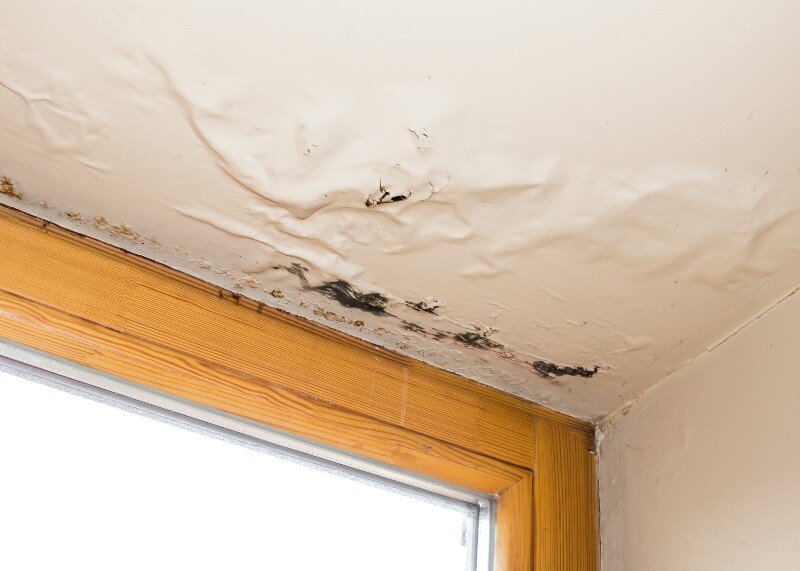
Homeowners do not want to look up and see signs of ceiling water damage. Several things can cause a water-damaged ceiling, and you could have a leaky roof or burst pipes. At the first sign of water stains, you should look for the source of the water. You want to prevent further damage like discoloration and mold growth.
Homeowners can repair the ceiling if the affected area isn’t too big. If the whole ceiling has been affected, you may want to contact a restoration company to ensure no structural damage. We will cover everything you should do when you notice a ceiling leak.
Ceiling Water Damage – How to Fix the Damage
Homeowners must fix the water leak before they can tackle ceiling repair. You may have to hire a plumber to determine the source of the leak because even a water pipe with a small hole can cause a great deal of damage.
You may have to hire a company that specializes in water damage restoration. These companies are experts in mold remediation; the last thing you want to see is mold or mildew after you repair the damaged area.
If you are considering selling your house, you must repair any signs of water damage. You may have fixed the source of the water leak, but evidence of the leak may be staining your ceiling. These water stains are a red flag to potential buyers unless you go with a company specializing in houses requiring repairs.
Cash home buyers in New Jersey will offer you a fair market offer for your house, and you will not have to worry about repairing your home.
Identifying Ceiling Water Damage
You may be able to identify a ceiling leak when you see water dripping from the ceiling to the floor. Sometimes, the water leak will be less apparent. You may have musty smells coming from some areas of the room.
The most apparent sign of ceiling water damage is a brownish water stain. You may also see peeling or bubbling paint, and water leaking through the ceiling can get trapped by the latex paint.
Finding the Source of the Damage
It is essential to find the source of the leak and fix it before repairing the ceiling. Homeowners should inspect the area above the leak. Ensure that any appliance that uses water, such as their washing machine, is working correctly.
Sinks, toilets, and bathtubs are often the cause of minor leaks. You can quickly repair these leaks by applying some caulking to areas where water is seeping. If you think there might be a more significant leak due to a broken pipe, your best bet is to hire a plumber.
Another concern would be roof leaks. The first place you should check is the attic. Inspect the attic for any signs of dampness or moisture. If you see any signs of a water leak, you will have to check the roof for the source of the leak.
You may find roof damage that you can quickly repair by replacing some shingles. After you locate the source of the leak, you will have to fix it or hire someone that can.
If there doesn’t seem to be any roof damage, you should check your gutters. Gutters full of leaves can cause water to seep into your home. Clear the gutters and drains and ensure that they are correctly installed.

Repairing the Source of the Damage
Once you have repaired the source of the damage, it is vital to remove any excess moisture from the affected area. Water can lead to mold and mildew, another complex problem.
If you are dealing with a company specializing in restoration services, they will bring dehumidifiers to dry out the area.
Cosmetic Repairs To Make After Ceiling Water Damage Is Repaired.
It is impossible to hide flaws in your ceiling. You can’t hang a picture to cover water stains. Hopefully, the water leak did not affect the entire ceiling. Inspect the area around the water leak. You may find that the water has found its way down the wall. It is essential to replace any drywall with any sign of water damage.
Repairing a ceiling can be a very messy task. You must remove any valuables from the room before you start working, and cover furniture with sheets to protect it from the dust you will create throughout the repairs.
You can fix small cracks or holes with a joint compound. Apply the joint compound, which is also known as mud. You can apply the joint compound with a putty knife. Cover with drywall mesh tape and then reapply the joint compound.
Allow the area to dry, and then sand the area. Reapply the joint compound and continue the process until the area is completely smooth. Once you are happy with your results, you can start painting.
Ensuring Structure Is Safe
It might be necessary to consult with a contractor if you need clarification on the extent of the damage to your ceiling. You must be sure that the ceiling is structurally sound, especially if it is a ceiling in a ground room floor with a room above it. The contractor may determine that your house is unsafe if there is extensive damage.
Homeowners that do not want to invest in expensive repairs may decide that selling an uninhabitable house is the wisest decision. You can sell your home to a company that deals with these problems.
You will have to remove any damaged drywall from the ceiling. You must ensure that you have repaired the source of the leak and there is no sign of moisture. Once the area is moisture-free, you can install a new piece of drywall.
Fasten the drywall into place and then seal the seams with joint compound. Sealing the joints and smoothing the area will take time and patience. Allow time for the compound to dry, and then sand over it. The goal is to achieve a smooth finish. You can repeat this process until the replacement drywall is unnoticeable.
Removing any Damp From the Room
It would be best if you placed some dehumidifiers in the room to remove any moisture before starting the repairs. You may have to leave the dehumidifiers in place for a day or two to ensure the areas are completely dry.
It is essential to place the dehumidifiers in the room with the damaged ceiling and near the source of the original leak. You want to remove any excess moisture from your home before it leads to mold. Once the water has seeped into your drywall, it can quickly develop into mold and spread quickly throughout your home.
Replastering Your Ceiling
Removing any damaged paint or plaster with a putty knife is essential. Scrape the damaged area until it is completely smooth. You can fill any holes or cracks with a joint compound. Apply the compound and allow it to dry.
You can apply one coat of primer. Inspect the ceiling for areas that you must smooth out. Apply more joint compound, and then apply another coat of primer. Once the compound is dry, you can start to sand it. You should wear safety glasses because sanding joint compounds creates a great deal of fine dust.
Sand until the ceiling is smooth. When you are happy with the results, apply another coat of primer. Once the primer is dry, you can start painting. You can blend in the area to match the rest of the ceiling, or you can paint the entire ceiling.
Repainting Your Ceiling
You can repaint the affected area with latex ceiling paint. If it hasn’t been that long since you painted your ceiling, you should be able to blend it so it is hardly noticeable. Unfortunately, if it has been some time since you last painted, you might not be able to hide the repairs unless you repaint the entire ceiling.
If you consider putting your house on the market, you must make your ceiling look brand new. However, you can go with a company whose slogan is we buy houses Camden or sell a house fast in Cherry Hill, and you can leave the worry of repairs up to them. You can walk away from your home with a cheque in your hand.
If you sell your house yourself, you should have a home inspection. You want to pass a home inspection checklist for sellers before putting your home on the market. This list is the same inspection list that a buyer will have done before buying the house. The selling process will be much easier if everything on the list passes inspection.
Conclusion Paragraph
No one wants to see water damage on their ceilings. Water leaks happen to every homeowner at some time or other. Knowing what to do will help you solve the problem quickly and efficiently.
You may decide to tackle the problem yourself, or you may decide that you should hire a contractor and a restoration company.

 Call Us!
Call Us!